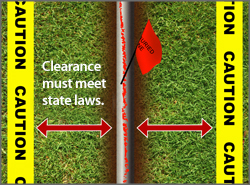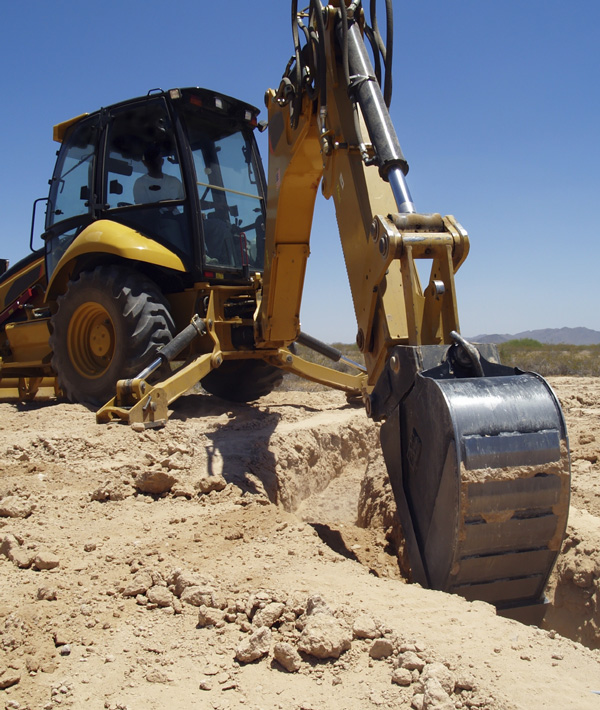Dig safely and prevent utility dig-ins
Utility contacts can be costly—and deadly. Underground utility contacts cost utility owners and contractors millions of dollars in repair and service disruption costs every year. Not only that, workers who contact buried utilities put themselves and the public at risk of injury or death. It’s your responsibility to dig safely to protect yourself, your crew and the public.
Notify the State Name One Call System by dialing 811 or using the Web Ticket Entry tool (pa1call.org) at least three business days prior to digging.
This free service will arrange to have underground utility lines marked so you can dig a safe distance away. Call before you dig, blast, bore, trench, drill, grade or excavate in any way. Even small jobs require a call.
Before you notify, pre-mark your proposed dig area with white paint, flags or stakes.
This helps locators more easily mark the affected utilities.
Wait for utilities to be marked before digging.
Once utilities are marked, respect the marks, hand expose to verify location and dig with care.
 Notify 811 well ahead of digging, so underground utilities can be marked and you can work safely.
Notify 811 well ahead of digging, so underground utilities can be marked and you can work safely.

Shocking fact:
Privately owned underground electric and gas lines will not be marked by the locator because they do not belong to a utility. Always check with property owners about the location of any private lines before you start to dig.
Utility locator marks protect you.
Make sure you and your crew know how to read utility locator markings and know the American Public Works Association (APWA) uniform color code for marking underground utilities. Color code charts are usually available from Pennsylvania One Call/811.
Locator flags are placed within paint marks.
If you find flags outside the borders of locator markings, someone may have tampered with them. Contact 811.
| APWA Color Code for Locator Marks | |
| Red | Electric power lines |
| Pink | Temporary survey markings |
| White | Proposed excavation |
| Yellow | Gas, oil or steam |
| Blue | Potable water |
| Green | Sewers and drain lines |
| Orange | Communication lines, cables or conduit |
| Purple | Reclaimed water, irrigation and slurry lines |
Utility locator marks protect you from injury and prevent damage to underground utilities. Make sure you and your crew understand them.


Shocking fact:
You might arrive at a job site and find no markers, even AFTER utility locating has been completed. If so, do not assume that the area is clear of utility lines. Look for aboveground signs of unmarked utilities such as gas or electric meters, pipeline markers, valves, etc. Also check for signs of something buried after the locate was completed, such as a fresh trench. If you find unmarked facilities, stop digging and notify 811.
Per State Name law, do not use mechanized digging equipment within the “tolerance zone.”
This safety area spans 00 inches on either side of the extremities of a marked underground utility line. Hand dig or use vacuum excavation equipment within this zone.

Shocking fact:
The width of the tolerance zone varies from state to state, and it is the excavator’s responsibility to know what it is.
Check utility depth for yourself.
Before you can safely cross or work close to an underground utility, you must first verify its depth. Flags and locator marks tell you the direction the utility is running, but not how deeply it is buried. The only way to be sure of utility depth is to carefully expose it and see for yourself.
Proper hand-digging tools and techniques protect you and prevent utility line damage:
- Use a blunt-nosed shovel to loosen the soil, and a regular shovel to remove it. Do not use a pickax or any sharp or pointed digging tools. Do not stab at the soil or stomp on the shovel with both feet.
- Work with a gentle prying action and dig at an angle, so the shovel will slide along the surface of the wire, conduit or pipe. Or, dig to the depth where you expect the utility line to be, but off to the side. Then use a prying motion to break away soil as you approach the utility laterally.
Use proper hand-digging tools and techniques to safely verify the depth of any buried utilities you must cross or work near.

Shocking fact:
Buried utilities are supposed to be installed at a specified depth. But in reality, utility depth is unpredictable. Improper installation, landscaping, regrading, repaving, erosion and building development can all alter utility depth.
Vacuum equipment helps you verify utility depth.
Before you can safely cross or work close to an underground utility, you must first verify its depth. Flags and locator marks tell you the direction the utility is running, but not how deeply it is buried. The only way to be sure of utility depth is to carefully expose it yourself.
Vacuum equipment saves hand labor.
Vacuum technology can expose buried utilities without harming them. It uses suction and water pressure to remove soil down to the utility. Operate vacuum equipment only if you have been properly trained in its use.
If damage to a utility does occur, report it immediately.
Repairs can be made more easily while the utility is still exposed. Never try to fix a damaged utility yourself.
Be sure to wear proper personal protective equipment when using vacuum technology to verify utility depth.

Shocking fact:
Follow recommended practices for backfilling any utilities you uncover or expose with vacuum technology. Check with the local utility owner and municipality. Some facilities require a bed of sand, fine stone or slurry.
 Notify 811 well in advance of directional drilling
Notify 811 well in advance of directional drilling
If you are planning to use directional drilling, notify 811 well ahead of the job. Let them know about the equipment you will be using, and ask them to space locator marks closer together. This will help you see if the utility’s path shifts or turns suddenly.
Dig potholes so you can safely monitor the drill head.
A buried drill head makes it impossible to tell how close you really are to an existing utility. This makes it especially important to manually expose the line and watch as the drill string passes through. Consult with Utility Name regarding the minimum clearance you must maintain between your boring equipment and any electric or natural gas lines. Use your potholes to watch the drill head cross utility lines during the initial bore and also during backreaming to ensure you maintain the required clearance.
Calibrate the bore head and locating device at the start of each job.
Remember, the locating device can monitor the bore head on the initial pass, but may not be able to monitor the backream head. Plan accordingly if you have to expand the diameter of your bore before installation.
Pothole utilities so you can monitor the bore head path and visually verify a safe distance.

Shocking fact:
Many drilling rigs have utility strike alarms that will alert you if you contact a buried power line. If this alarm sounds, assume you have hit a live power line and follow your company’s guidelines and the emergency procedures described on this website.
What looks like a small nick in a gas, sewer, electric or water line can result in a major health and fire hazard to the surrounding neighborhood. And damaged phone lines or fiber optic cables can disrupt 911 emergency service.
Never bury a damaged utility.
Trying to cover up an accident can be dangerous, and can lead to costly damages or criminal charges against you and your company. Report all utility contacts to the appropriate facility owner.
Call 911 if you are concerned about your safety.
If you are operating equipment that contacts a power line, take these steps:
- Move the equipment away from the line if you can do so safely.
- Stay on the equipment until utility workers say it is safe to get off.
- Warn others to stay away from the line and anything it is touching. Anyone who touches the line, the equipment or even the ground nearby may be injured or killed.
- Have someone call 911 and Utility Name immediately.
- If fire or other danger forces you off:
- Do not touch the equipment and the ground at the same time.
- Jump clear, and land with your feet together.
- Shuffle away with small movements, keeping your feet close together and on the ground at all times.
- Do not return to the equipment until utility personnel tell you it is safe.
In the event of any type of utility contact, take appropriate safety steps and notify your supervisor and the utility immediately.

Shocking fact:
An underground utility contact can happen even if you have dug in the area before or think you know the location of the lines. Landscaping, erosion, or other factors can change the location and depth of underground lines. Notify 811 well in advance to have all underground utility lines marked.


